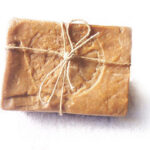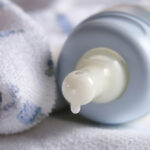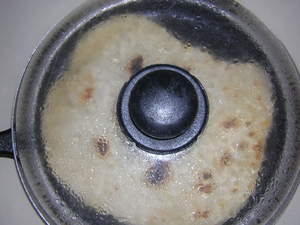Since our culture is so highly dominated by bottle-feeding, it surprises many mothers to find out that many breastfed babies never drink from a bottle at all. Despite common misconceptions, there is no reason for introducing a bottle to a baby at any age. Even if a breastfed baby’s diet must be supplemented with expressed breastmilk, water, or formula, cup feeding is a viable alternative to the bottle for babies of all ages.
Even a newborn can learn to drink with little help from an open-ended cup, though babies up and toddlers up to eighteen months old will probably require some assistance unless it has a sippy-cup lid. Surprisingly, a breastfed baby who never takes a bottle will be much more accepting of a cup during infancy and toddlerhood than a baby who has taken a bottle all along. This fact, and the many concerns that relate to bottle-feeding after the first few months, is good reason to skip the bottle entirely.
A sippy cup, while excellent for a toddler, does not work well for young babies because they are naturally inclined to pucker their lips to suck, whether they are typically breastfed or bottle-fed. Depending on the baby’s age, you can begin by introducing the cup to the baby using a one-ounce medicine cup, a shotglass, or a two-handled cup made for young children.
If your baby is less than roughly four months of age, help her to drink from a one-ounce medicine cup by sitting with her in your lap, with her head and back supported by your arm or a pillow. Fill the cup three-quarters full with whatever liquid you’ll need to use as a supplement, and press the rim of the cup against the baby’s lips. She may begin lapping eagerly at the milk, and may even put her hands on the sides of the cup (an older baby may snatch it entirely). Do not pour the liquid down the baby’s throat: instead, slowly tilt it so that it gradually enters the baby’s mouth.
As a baby gets older, and is able to sit up unsupported and hold a two-handled cup, you can introduce the cup to him by simply allowing him to hold it himself. A baby as young as five months can sometimes astonish parents by drinking gracefully from a cup without any support whatsoever, though it is wise to allow him to practice with water before giving him a cup filled with precious breastmilk. If he must drink breastmilk and not water, guide him and hold him while he gets the hang of it– you may be surprised by how quickly he catches on.
Some parents are concerned that cup-feeding might be dangerous or stressful to a young baby, but scientific evidence shows otherwise. One clinical revealed that, though a baby’s blood oxygen levels drop while he drinks from a cup, the decline is no more severe than the physiological distress caused by bottle feeding. While breastfed babies have the lowest stress levels, bottle-fed and cup-fed babies experience equal levels of stress, so the bottle offers no advantage in this case.
Cup feeding is a healthy, safe, and enjoyable alternative to introducing the bottle to a breastfed baby, and it is not a difficult task to accomplish. The vast majority of breastfed babies, even those who entirely reject the bottle, will take eagerly to a cup at any age, and the benefits that this offers over bottle-feeding are numerous.
Source Used: CR Howard, et al. Physiologic Stability of newborns during cup- and bottle- feeding. Pediatrics. 1999 Nov;104(5 Pt 2):1204-7



